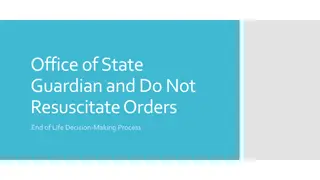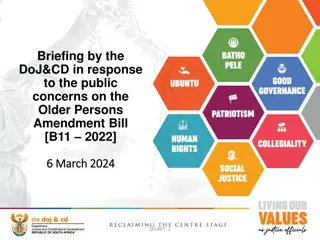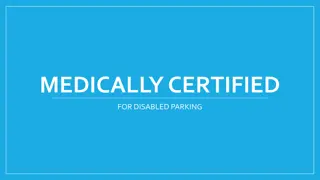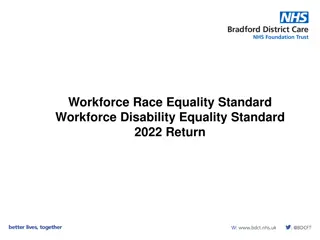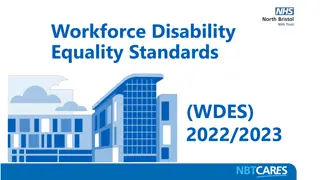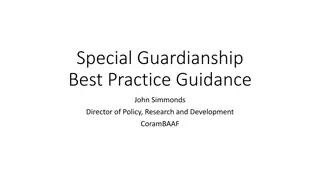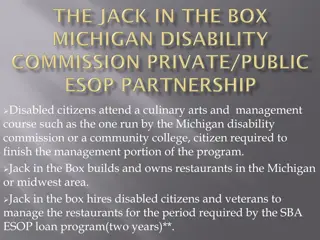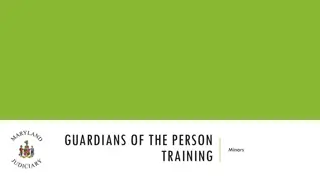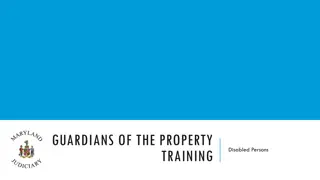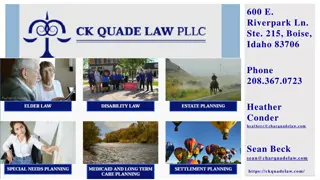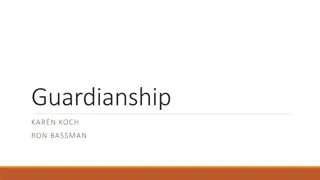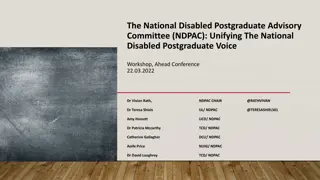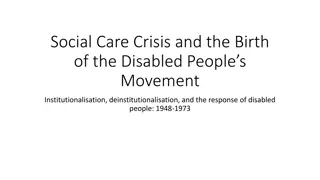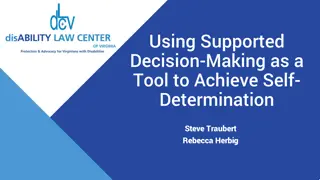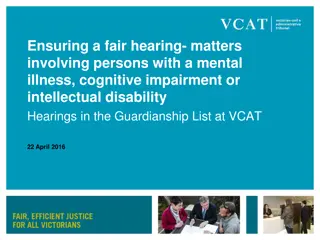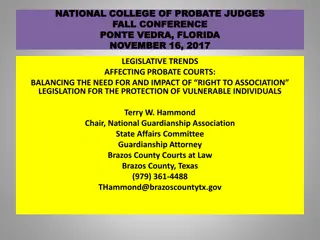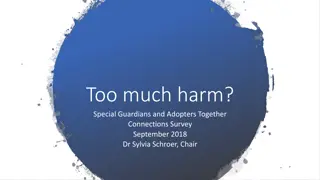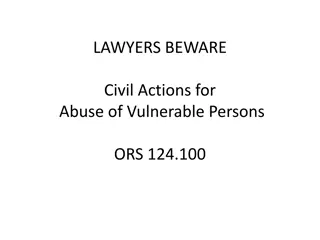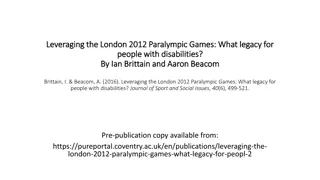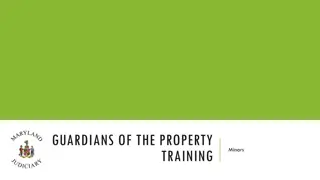Understanding Guardianship for Disabled Persons Training
This informative content covers various aspects of guardianship for disabled persons, including terms, roles, decision-making, abuse prevention, and changes to guardianship. It explains key terms, the role of the court, types of guardians, estate management, responsibilities of clerks/trust clerks, interested persons, and other parties involved in the process.
Download Presentation

Please find below an Image/Link to download the presentation.
The content on the website is provided AS IS for your information and personal use only. It may not be sold, licensed, or shared on other websites without obtaining consent from the author. Download presentation by click this link. If you encounter any issues during the download, it is possible that the publisher has removed the file from their server.
E N D
Presentation Transcript
GUARDIANS OF THE PERSON Disabled Persons TRAINING
WELCOME Part 1: Guardianship terms Part 2: Role, powers, and duties Part 3: Decision-making Part 4: Abuse, neglect, and exploitation Part 5: Changes to the guardianship
PART 1: GUARDIANSHIP TERMS Guardianship terms Disabled Person Court Guardian Guardianship Estate Clerk/Trust Clerk Interested Persons Other Parties
DISABLED PERSON Also called: Disabled adult Ward Incapacitated person Person under guardianship Vulnerable adult Lacks the physical or mental capacity to provide for their personal or financial needs
COURT The court is the ultimate guardian You are its agent Monitors the guardianship Review reports Address issue or problems
GUARDIAN Two types: 1. Guardian of the Person Public Guardian 2. Guardian of the Property (Fiduciary) Co-Guardians
GUARDIANSHIP ESTATE The disabled person s assets (property) that are under guardianship, including any: Income Real or personal property Benefits Stocks, bonds, investments
CLERK/TRUST CLERK Court employee whose responsibilities may include: Managing the guardianship case Processing all case paperwork Collecting fees Providing court forms Sending out notices Answering questions about court process Reviewing reports Reporting problems to the court
INTERESTED PERSONS The law defines Interested Persons in a guardianship to include: The disabled person The disabled person s Spouse Parents Children (aged 18+) Other relatives Heirs Agencies the disabled person receive benefits and services from Any other persons named by the court
OTHER PARTIES Other parties important in a guardianship include: Family members and friends of the disabled person Health care and other service providers
PART 2: ROLE, POWERS, DUTIES Role, powers, and duties of guardians of the person Filing and reporting requirements
ROLE AS GUARDIAN OF THE PERSON Guardianship order Powers necessary to provide for the demonstrated need of the disabled person What you can and cannot do Proof of your appointment and authority
POSSIBLE POWERS The court may give you the power to do any of the following: Determine where the disabled person lives Provide for the disabled person s care, comfort, and maintenance Care for the disabled person s personal effects Arrange for services and care Request funds for the disabled person s care from the guardian of the property (if one is appointed) Give necessary consent or approval for medical or other professional care
PRIOR COURT AUTHORIZATION Get prior court approval before: performing any action not authorized in the order appointing you as guardian moving the disabled person from one type of housing to another committing the disabled person to a mental facility involuntarily starting, stopping, or withholding medical treatment that would involve a substantial risk to life of the disabled person Ask the court for permission in writing.
FILING AND REPORTING REQUIREMENTS Annual Report of Guardian of Disabled Person Within 60 days of appointment date Use Form CC-GN-013 Tip: Complete the entire form Write not applicable in sections where you have no information to include.
PART 3: DECISION-MAKING Decision-making standards Ethical considerations Medical decisions Community resources
DECISION-MAKING STANDARDS 1. Substituted Judgment Based on what disabled person would do if he or she could 2. Best Interest Option with the most benefit and the least harm 3. Least Restrictive Alternative Meets the disabled person s needs and places the fewest restrictions on dignity and independence 4. Informed Consent Understand the purpose, risks, benefits, and alternative to any service you consider
SUBSTITUTED JUDGMENT Disabled Person Preferences Values Lifestyle Behaviors Past decisions Beliefs Religious Moral Ethical Cultural Substituted Judgment Opinions Family members Friends Caregivers Clergy Attorneys Past expressions of wishes or desires Will or living will Power of attorney Advanced directive Contract
BEST INTEREST Weigh benefits against risks Burdens Benefits Choose the option with the most benefit and least harm Least restrictive Least intrusive Independent opinions: Doctors Social workers Attorneys Government agencies
LEAST RESTRICTIVE ALTERNATIVE Meets the needs but places the fewest restrictions on the disabled person s independence and dignity Consider: Disabled person s preferences Opinions of professionals Community resources
INFORMED CONSENT Give informed consent for care, treatment, or services Purpose Risks Consent must be given freely, without coercion or undue influence Informed Consent Benefits Alternatives
ETHICAL CONSIDERATIONS Extreme care and diligence Trust, loyalty, and fidelity Least restrictive environment Informed consent Terminate or limit guardianship when needed
MEDICAL DECISIONS What does the disabled person want? Am I allowed to consent? Do I need more information? What do the experts say?
WHAT DOES THE DISABLED PERSON WANT? Substituted Judgment Include the disabled person Disabled Person Preferences OR use substituted judgment OR use best interest standard Effect on physical, emotional, and cognitive function Risks, benefits, side effects Effect on life expectancy and chance of recovery Humiliation, loss of dignity, and dependency Religious, cultural, moral beliefs Personal values Will or living will Advanced directives Documents Attitudes Outlook toward treatment Expressions of concern Opinions Religious Moral Ethical Cultural Beliefs & Values
LIFE-SUSTAINING/END-OF-LIFE DECISIONS You MUST get court approval to: Withhold or withdraw life-sustaining medical procedures, care, or treatment Execute Do Not Resuscitate (DNR) Order Do Not Intubate (DNI) Order Removal of a feeding tube
COMMUNITY RESOURCES Case management Information and referrals *Program Eligibility Meals Health care In-home aide services Transportation Mental and behavioral health resources Legal advocacy Public benefit eligibility Social, recreational, and educational programs Crisis intervention
MARYLAND ACCESS POINT Meals Housing Home repairs Long-term care, nursing home, or assisted living Adult day care Caregiver support Transportation Personal care Healthy living Medication management and other medical assistance www.marylandaccesspoint.info 1-844-627-5465
PART 4: ABUSE, NEGLECT, AND EXPLOITATION Types and signs People under guardianship often targeted because of: Age Physical, intellectual, or emotional limitations Dependence on others for basic needs Inability to communicate they are being hurt Limited ability to recognize and avoid danger A signal indicator is usually not proof Look for patterns or suggestions of a problem Victims of crime can suffer from physical psychological, and financial injuries
PHYSICAL ABUSE Complaint Unexplained or poorly explained injuries Use of force that may result on bodily injury, physical pain, or impairment Fractures, sprains, dislocations, bleeding Hitting, beating, pushing, shoving, shaking, or slapping Bruises, bites, cuts, sores, burns, scars, head trauma Behavior Changes Signs Withdrawal, aggression, regression, depression Substance abuse, attempts to escape, wariness, fear Sudden Changes Kicking, pinching, choking, hair pulling, or burning Weight loss, tooth loss, or hair loss Use of drugs or physical restraints, force-feeding, reckless driving, physical punishment Different explanations for injuries Fear of a particular person Frequent/suspicious hospitalizations Delays in treatment Other
SEXUAL ABUSE Complaint Nonconsensual sexual contact of any kind Injuries Includes: Rape and molestation Sexual conduct with a person unable to consent Behavior Changes Victims include: Women and men Children and people with disabilities especially vulnerable Inappropriate, unusual, or aggressive behavior Bedwetting, sleep disruptions Fear of the dark, avoids undressing, overdresses Signs
EMOTIONAL ABUSE Complaint The infliction of pain, anguish, or distress Changes Verbal assaults, insults, threats Weight loss or gain Depression, confusion, agitation, withdrawal Physical signs Also known as psychological abuse Signs Intimidation, humiliation, harassment Rashes, hives, facial tics, stomach aches, elevated blood pressure Isolation from family, friends, activities Nervous habits (biting, rocking, head- banging, bedwetting, thumb sucking)
PERPETRATORS OF ABUSE Can be anyone Often someone the victim knows Family members Acquaintances Dating partners Caregivers
NEGLECT Poor hygiene (lice, scabies, severe or untreated rashes or wounds, bedsores) A caregiver s refusal or failure to provide for a person s basic needs Food, water, clothing, shelter Personal hygiene, medication, comfort, personal safety Malnutrition or dehydration Hazardous or unsafe conditions (bad wiring, no heat, poor plumbing, unsanitary conditions) Dirt, fleas, bed bugs, soiled bedding, odors Passive neglect Caregiver unable to fulfill obligations Inadequate clothing, lack of basic medical care or medications Intentional neglect Caregiver able to but refuses to fulfill obligations Exposure to elements (sunburn, bites, cold) Neglectors can be family members, caregivers, or staff at care facilities Behaviors that are not age-appropriate (wetting, soiling)
SELF-NEGLECT When a person refuses to care for him/herself Declining health Mental health issues Dementia Substance abuse Depression Significant mental illness Failure to care for food, clothing, personal hygiene, medical needs Malnutrition, dehydration, untreated or poorly treated medical conditions Hoarding, cluttering, unsafe/unsanitary living conditions, (poor wiring, no heat, bad plumbing)
RESPONDING TO SUSPECTED ABUSE OR NEGLECT If someone is in immediate danger, call 9-1-1. Suspect abuse? Child Protective Services (under 18 years old) Adult Protective Services (over 18 years old) Investigate concerns about the safety or well-being of children and vulnerable adults Offer services and support Leave investigation to the professionals
PREVENTING ABUSE AND NEGLECT Visiting the person under guardianship Monitor care Track changes Behavior, physical appearance, physical surroundings Specific complaints Unexplained injuries or conflicting explanations Depression, fear, agitation, withdrawal Appropriate clothing, hygiene, living space Track people Specific complaint Reluctance/unwillingness to see certain people Interference by others Is money paid being used properly? Receiving proper care? Food, housing, clothing needs met? Suspicious doctor/hospital visits? Conflicting explanations for injuries?
PART 5: CHANGES TO THE GUARDIANSHIP Termination Resignation Removal End of Appointment
TERMINATION The guardianship can terminate when: Disabled person dies Disabled person recovers from disability (cessation) Other good cause Upon death Copy of death certificate Recovery from disability Physician examination within 21 days of filing the petition Medical Certificate Cessation of Disability Guardians of the property Notify the court! Within 45 days: Petition to Terminate the Guardianship Show cause order Include a final Fiduciary s Account Proposal for distribution of remaining assets
RESIGNATION No longer able to serve? Petition for Resignation of Guardian May request: Substituted or Successor Guardian (replacement) Include a final Fiduciary's Account Show cause order Resignation not automatic Court order accepting your resignation Continue responsibilities as guardian
REMOVAL Removal as guardian Court Show cause Petition from Interested person Petition for Removal of Guardian Hearing Removal Perform neglected duties Other sanctions Removal not automatic Court order removing you as guardian Continue responsibilities File a final Fiduciary's Account
END OF APPOINTMENT Rights and responsibilities end upon termination Does not discharge you from liability for wrongful acts
QUESTIONS? Visit: www.mdcourts.gov/guardianship Forms Videos Resources
GUARDIANS OF THE Disabled Persons PERSON & PROPERTY TRAINING


